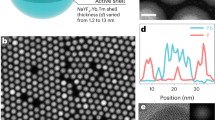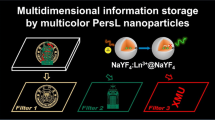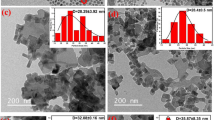Abstract
Sodium gadolinium fluoride (NaGdF4) is an ideal host material for the incorporation of luminescent lanthanide ions because of its high photochemical stability, low vibrational energy and its ability to mediate energy exchanges between the lanthanide dopants. This protocol describes the detailed experimental procedure for synthesizing core-shell NaGdF4 nanoparticles that incorporate lanthanide ions into different layers for efficiently converting a single-wavelength, near-IR excitation into a tunable visible emission. These nanoparticles can then be used as luminescent probes in biological samples, in 3D displays, in solar energy conversion and in photodynamic therapy. The NaGdF4 nanoparticles are grown through co-precipitation in a binary solvent mixture of oleic acid and 1-octadecene. Doping by lanthanides with controlled compositions and concentrations can be achieved concomitantly with particle growth. The lanthanide-doped NaGdF4 nanoparticles then serve as seed crystals for subsequent epitaxial growth of shell layers comprising different lanthanide dopants. The entire procedure for the preparation and isolation of the core-shell nanoparticles comprising two epitaxial shell layers requires ∼15 h for completion.
This is a preview of subscription content, access via your institution
Access options
Subscribe to this journal
Receive 12 print issues and online access
$259.00 per year
only $21.58 per issue
Buy this article
- Purchase on Springer Link
- Instant access to full article PDF
Prices may be subject to local taxes which are calculated during checkout






Similar content being viewed by others
References
Haase, M. & Schäfer, H. Upconverting nanoparticles. Angew. Chem. Int. Ed. 50, 5808–5829 (2011).
Blasse, G. & Grabmaier, B.C. Luminescent Materials (Springer, 1994).
Auzel, F. Upconversion and anti-stokes processes with f and d ions in solids. Chem. Rev. 104, 139–174 (2004).
Downing, E., Hesselink, L., Ralston, J. & Macfarlane, R. A three-color, solid-state, three-dimensional display. Science 273, 1185–1189 (1996).
van der Ende, B.M., Aartsa, L. & Meijerink, A. Lanthanide ions as spectral converters for solar cells. Phys. Chem. Chem. Phys. 11, 11081–11095 (2009).
Wang, J. et al. Enhancing multiphoton upconversion through energy clustering at sublattice level. Nat. Mater. 13, 157–162 (2014).
Wang, F. & Liu, X. Recent advances in the chemistry of lanthanide-doped nanoparticles. Chem. Soc. Rev. 38, 976–989 (2009).
Mader, H.S., Kele, P., Saleh, S.M. & Wofbeis, O.S. Upconverting luminescent nanoparticles for use in bioconjugation and bioimaging. Curr. Opin. Chem. Biol. 14, 582–596 (2010).
Zhou, J., Liu, Z. & Li, F. Upconversion nanophosphors for small-animal imaging. Chem. Soc. Rev. 41, 1323–1349 (2012).
Bünzli, J.-C.G. Lanthanide luminescence for biomedical analyses and imaging. Chem. Rev. 110, 2729–2755 (2010).
Liu, Q., Feng, W., Yang, T., Yi, T. & Li, F. Upconversion luminescence imaging of cells and small animals. Nat. Protoc. 8, 2033–2044 (2013).
Liu, Y., Tu, D., Zhu, H. & Chen, X. Lanthanide-doped luminescent nanoprobes: controlled synthesis, optical spectroscopy, and bioapplications. Chem. Soc. Rev. 42, 6924–6958 (2013).
Wu, S. et al. Non-blinking and photostable upconverted luminescence from single lanthanide-doped nanocrystals. Proc. Natl. Acad. Sci. USA 106, 10917–10921 (2009).
Idris, N.M. et al. In vivo photodynamic therapy using upconversion nanoparticles as remote-controlled nanotransducers. Nat. Med. 18, 1580–1585 (2012).
Zhang, Y. et al. Tuning the autophagy-inducing activity of lanthanide-based nanocrystals through specific surface-coating peptides. Nat. Mater. 11, 817–826 (2012).
Zhou, J. et al. Dual-modality in vivo imaging using rare-earth nanocrystals with near-infrared to near-infrared (NIR-to-NIR) upconversion luminescence and magnetic resonance properties. Biomaterials 31, 3287–3295 (2010).
Abel, K.A., Boyer, J.C. & van Veggel, F.C.J.M. Hard proof of the NaYF4/NaGdF4 nanocrystals core/shell structure. J. Am. Chem. Soc. 131, 14644–14645 (2009).
Park, Y. et al. Theranostic probe based on lanthanide-doped nanoparticles for simultaneous in vivo dual-modal imaging and photodynamic therapy. Adv. Mater. 24, 5755–5761 (2012).
Wang, F., Wang, J. & Liu, X. Direct evidence of a surface quenching effect on size-dependent luminescence of upconversion nanoparticles. Angew. Chem. Int. Ed. 49, 7456–7460 (2010).
Alivisatos, A.P. Semiconductor clusters, nanocrystals, and quantum dots. Science 271, 933–937 (1996).
Medintz, I.L., Tetsuouyeda, H., Goldman, E.R. & Mattoussi, H. Quantum dot bioconjugates for imaging, labelling and sensing. Nat. Mater. 4, 435–446 (2005).
Jin, R. et al. Photoinduced conversion of silver nanospheres to nanoprisms. Science 294, 1901–1903 (2001).
Rosi, N.L. & Mirkin, C.A. Nanostructures in biodiagnostics. Chem. Rev. 105, 1547–1562 (2005).
Ehlert, O., Thomann, R., Darbandi, M. & Nann, T. A four-color colloidal multiplexing nanoparticle system. ACS Nano 2, 120–124 (2008).
Wang, F. & Liu, X. Upconversion multicolor fine-tuning: visible to near-infrared emission from lanthanide-doped NaYF4 nanoparticles. J. Am. Chem. Soc. 130, 5642–5643 (2008).
Wang, F., Xue, X. & Liu, X. Multicolor tuning of (Ln, P)-doped YVO4 nanoparticles by single-wavelength excitation. Angew. Chem. Int. Ed. 47, 906–909 (2008).
Mahalingam, V., Vetrone, F., Naccache, R., Speghini, A. & Capobianco, J.A. Colloidal Tm3+/Yb3+-doped LiYF4 nanocrystals: multiple luminescence spanning the UV to NIR regions via low-energy excitation. Adv. Mater. 21, 4025–4028 (2009).
Wong, H.-T., Chan, H.L.W. & Hao, J. Towards pure near-infrared to near-infrared upconversion of multifunctional GdF3:Yb3+,Tm3+ nanoparticles. Opt. Express 18, 6123–6130 (2010).
Chen, G. et al. Lanthanide-doped ultrasmall yttrium fluoride nanoparticles with enhanced multicolor upconversion photoluminescence. J. Mater. Chem. 22, 20190–20196 (2012).
Wang, J., Wang, F., Wang, C., Liu, Z. & Liu, X. Single-band upconversion emission in lanthanide-doped KMnF3 nanoparticles. Angew. Chem. Int. Ed. 50, 10369–10372 (2011).
Chen, G., Liu, H., Somesfalean, G., Liang, H. & Zhang, Z. Upconversion emission tuning from green to red in Yb3+/Ho3+-codoped NaYF4 nanocrystals by tridoping with Ce3+ ions. Nanotechnology 20, 385704 (2009).
Su, Q. et al. The effect of surface coating on energy migration-mediated upconversion. J. Am. Chem. Soc. 134, 20849–20857 (2012).
Wang, F. et al. Tuning upconversion through energy migration in core–shell nanoparticles. Nat. Mater. 10, 968–973 (2011).
Qian, H. & Zhang, Y. Synthesis of hexagonal-phase core–shell NaYF4 nanocrystals with tunable upconversion fluorescence. Langmuir 24, 12123–12125 (2008).
Chen, D., Lei, L., Yang, A., Wang, Z. & Wang, Y. Ultra-broadband near-infrared excitable upconversion core/shell nanocrystals. Chem. Commun. 48, 5898–5900 (2012).
Chen, F. et al. Positive and negative lattice shielding effects co-existing in Gd (III) ion doped bifunctional upconversion nanoprobes. Adv. Funct. Mater. 21, 4285–4294 (2011).
Zhang, F. et al. Direct imaging the upconversion nanocrystal core/shell structure at the subnanometer level: shell thickness dependence in upconverting optical properties. Nano Lett. 12, 2852–2858 (2012).
Zhang, C. & Lee, J.Y. Prevalence of anisotropic shell growth in rare earth core-shell upconversion nanocrystals. ACS Nano 7, 4393–4402 (2013).
Yi, G. & Chow, G.M. Water-soluble NaYF4:Yb, Er(Tm)/NaYF4/polymer core/shell/shell nanoparticles with significant enhancement of upconversion fluorescence. Chem. Mater. 19, 341–343 (2007).
Johnson, N.J.J., Korinek, A., Dong, C. & van Veggel, F.C.J.M. Self-focusing by Ostwald ripening: a strategy for layer-by-layer epitaxial growth on upconverting nanocrystals. J. Am. Chem. Soc. 134, 11068–11071 (2012).
Sun, S., Murray, C.B., Weller, D., Folks, L. & Moser, A. Monodisperse FePt nanoparticles and ferromagnetic FePt nanocrystal superlattices. Science 287, 1989–1992 (2000).
Yin, Y. & Alivisatos, A.P. Colloidal nanocrystal synthesis and the organic–inorganic interface. Nature 437, 664–670 (2005).
Kwon, S.G. & Hyeon, T. Formation mechanisms of uniform nanocrystals via hot-injection and heat-up methods. Small 7, 2685–2702 (2011).
Wang, X., Zhuang, J., Peng, Q. & Li, Y. A general strategy for nanocrystal synthesis. Nature 437, 121–124 (2005).
Mai, H. et al. High-quality sodium rare-earth fluoride nanocrystals: controlled synthesis and optical properties. J. Am. Chem. Soc. 128, 6426–6436 (2006).
Boyer, J.C., Vetrone, F., Cuccia, L.A. & Capobianco, J.A. Synthesis of colloidal upconverting NaYF4 nanocrystals doped with Er3+, Yb3+ and Tm3+, Yb3+ via thermal decomposition of lanthanide trifluoroacetate precursors. J. Am. Chem. Soc. 128, 7444–7445 (2006).
Li, Z., Zhang, Y. & Jiang, J. Multicolor core/shell-structured upconversion fluorescent nanoparticles. Adv. Mater. 20, 4765–4769 (2008).
Ye, X. et al. Morphologically controlled synthesis of colloidal upconversion nanophosphors and their shape-directed self-assembly. Proc. Natl. Acad. Sci. USA 107, 22430–22435 (2010).
Park, Y.I. et al. Nonblinking and nonbleaching upconverting nanoparticles as an optical imaging nanoprobe and T1 magnetic resonance imaging contrast agent. Adv. Mater. 21, 4467–4471 (2009).
Liu, Y. et al. A strategy to achieve efficient dual-mode luminescence of Eu3+ in lanthanides doped multifunctional NaGdF4 nanoparticles. Adv. Mater. 22, 3266–3271 (2010).
Johnson, N.J.J., Oakden, W., Stanisz, G.J., Prosser, R.S. & van Veggel, F.C.J.M. Size-tunable, ultrasmall NaGdF4 nanoparticles: insights into their T-1 MRI contrast enhancement. Chem. Mater. 23, 3714–3722 (2011).
Wen, H. et al. Upconverting near-infrared light through energy management in core–shell–shell nanoparticles. Angew. Chem., Int. Ed. 52, 13419–13423 (2013).
Acknowledgements
This work was supported by the Agency for Science, Technology and Research (A*STAR), the National Research Foundation and the Economic Development Board (Singapore-Peking-Oxford Research Enterprise, COY-15-EWI-RCFSA/N197-1), and the Ministry of Education (MOE2010-T2-1-083). F.W. acknowledges CityU for a start-up grant.
Author information
Authors and Affiliations
Contributions
F.W. and R.D. performed the experiments. F.W., R.D. and X.L. developed the protocol. F.W. and X.L. wrote the manuscript.
Corresponding authors
Ethics declarations
Competing interests
The authors declare no competing financial interests.
Rights and permissions
About this article
Cite this article
Wang, F., Deng, R. & Liu, X. Preparation of core-shell NaGdF4 nanoparticles doped with luminescent lanthanide ions to be used as upconversion-based probes. Nat Protoc 9, 1634–1644 (2014). https://doi.org/10.1038/nprot.2014.111
Published:
Issue Date:
DOI: https://doi.org/10.1038/nprot.2014.111
This article is cited by
-
Upconversion nanoparticles: influence of the host lattices on crystallographic and luminescent properties
Journal of Materials Science: Materials in Electronics (2023)
-
Aptamer-based Upconversion Fluorescence Sensor for Doxorubicin Detection
Journal of Fluorescence (2023)
-
Next generation lanthanide doped nanoscintillators and photon converters
eLight (2022)
-
Bioconjugates of photon-upconversion nanoparticles for cancer biomarker detection and imaging
Nature Protocols (2022)
-
Super-resolution microscopy enabled by high-efficiency surface-migration emission depletion
Nature Communications (2022)
Comments
By submitting a comment you agree to abide by our Terms and Community Guidelines. If you find something abusive or that does not comply with our terms or guidelines please flag it as inappropriate.



